SCOUTING TRIP NOTES
INDONESIA
BIRD REPORT FOR
Northern Sulawesi
June 7 - 21, 2014
© 2014 Callyn Yorke
Ashy Woodpecker (Mulleripicus fulvus) Tombon Sulawesi 21 June 2014

© 2014 Callyn Yorke
Map of the Indo-Malayan Archipelago; Inset shows location of Bunaken Island and Manado, Northern Sulawesi
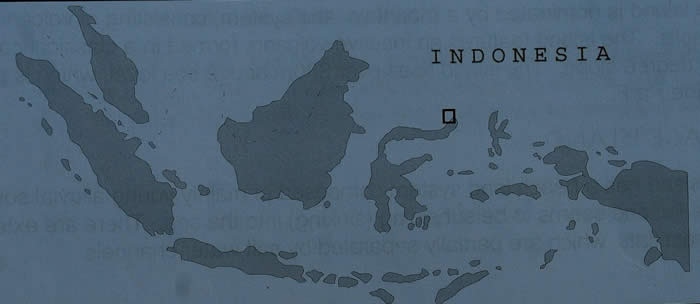
Map showing birding sites I visited in Northern Sulawesi
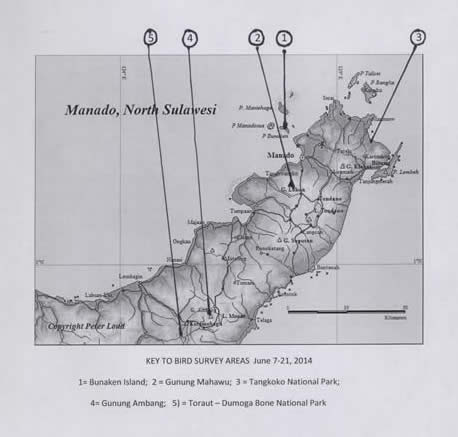
1= Bunaken Island; 2 = Gunung Mabawu; 3 = Tangkoko; 4 = Gunung Ambang; 5 = Toraut;Tomobon/ D-Bone
NORTHERN SULAWESI SYSTEMATIC BIRD LIST
June 7-21, 2014
Christophorus Merung Tangkoko National Park, Sulawesi 17 June 2014
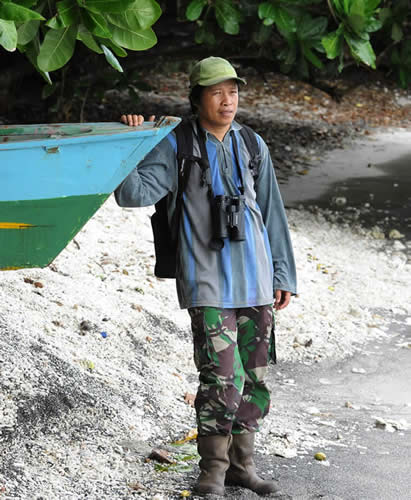
© 2014 Callyn Yorke
Weather: A full range of equatorial weather was observed, ranging from clear and warm afternoons (80F to 90F) to early morning and evening thundershowers (60F). Rainfall occasionally hampered our attempts to bird (e.g. Toraut and Gunung Mabawu) but was generally short in duration (i.e. < 1 hour). Humidity was usually high throughout the region (i.e. 80-95%). Ocean surface temperature averaged around 80F. June is usually considered the "Dry Season" in Northern Sulawesi, however global climate change has resulted in some deviations from this pattern, e.g. unexpected alternatiions of dry and wet spells.
Time: We generally began birding just after dawn (0600 hrs.) and, except for a few night-time excursions for owls, quit an hour before sunset (0630 hrs.). About 1.5 days were spent on roadways in transit.
Observers: Primarily Christo and I; also local park ranger-guides (e.g. Tangkoko and Tombon). I birded Bunaken Island alone.
Areas Covered (see map above): 1) Bunaken Island ( BI: June 7-13, 2014): Using the Living Colours Dive Resort as a base, I walked pathways through second-growth (i.e. jungle), coconut palm plantations, light agriculture (cassava, banana, mango) and weedy scrub ( e.g., Imperata cylindrica), between the main town on the southern shore, north about 0.5 mi. The only paved route through the area had fairly heavy motorbike traffic (mostly school children); side paths were generally quiet. I made a total of 6, 2-hour walking surveys (0600-0800 hrs.)in this area during my stay at the dive resort. At other times, I made casual observations of birds in and around the resort and adjacent mangroves. By the fourth or fifth survey, based on similar survey results, I had encountered (visually and aurally) an estimated 80% of the bird species likely to be present in the survey area (about 100 acres, representing roughly 17% of the island land area). Species of seasonal and/or distributional interest found on Bunaken Island during my surveys included, Pied Imperial Pigeon, Moluccan Swiftlet, White-vented Cuckoo-Shrike and Java Munia.
2) Gunung Mabawu, including the Highland Resort - Gunung Lukon area of Tomohon, Sulawesi (GM: June 13-16, 2014): Christos and I birded the lower and upper slopes of Gunung Mabawu (June 13: 1400-1600 hrs; June 14: 0600-0900 hrs.), including the rim of the crater of this inactive volcano (June 13 only). The slopes are covered by a mature lower-montane rainforest (photo), grading to smaller trees and weedy second growth near the rim. Most of the birdlife was found in the heavily wooded lower slope areas, where a paved road provided a convenient route for our walking surveys. Apparently, the Gunung Mabawu area is within a designated nature preserve; signs posted along the entrance road indicated that hunting and other disturbances were not permitted. The elevation of our surveys ranged between 2,000 and 3,000 ft above sea level. While staying at the nearby Highland Resort (HR), I birded their gardens and the adjacent hill forest below Gunung Lokon (an intermittently active volcano) in the morning and evening hours, weather permitting (June 14-15). Afternoon and early morning showers occurred frequently over the four-day period. Several Sulawesi endemics were found in this area, including, Greater Sulawesi Hanging Parrot, Yellow-billed Malkoa, Sulawesi Pygmy Woodpecker, Sulawesi Babbler, and Yellow-sided Flowerpecker.
Gunung Mabawu: a) forested lower slopes contained most of the birdlife b) second growth on rim of G. Mabawu (G. Lokon in background)
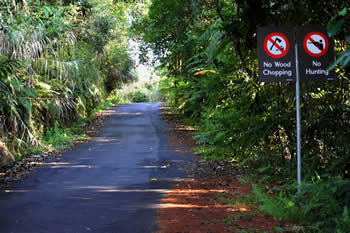

© 2014 Callyn Yorke
3) Tangkoko National Park (TNP: June 16-19 June, 2014): Our base of operations for this area was the Tangkoko Ranger Home Stay, located nextdoor to Mama Roo's Home Stay in Batu Putih village, bordering TNP (photo). The accomodations here were basic: a 10x10 ft. room with and attached bath. Both the bathroom sink and shower produced a dark brown liquid when initially turned on, grading to a tan-colored substance that represented the local running water supply for Batu Putih. The homestay fee (about $30) included three freshly prepared meals (e.g. steamed white rice, fish and vegetables) and drinking water (5-gallon bottles trucked in weekly). Our driver, Kiki and his brother-in-law, Christo, stayed here without charge, except for their food, for which I was held accountable. The location was convenient, being only steps away from the entrance gate to TNP. We were soon assigned a female ranger guide named Ace (pronounced ACHEY), one of only a few women among some forty male rangers working in the park. Her fee was about $10 per day; the TNP fee was $20 per day, payable at the park entrance by all foreigners (Indonesians and guides enjoy free admission to the park).
We spent most of the day and part of the evening (June 17: 0530-0930 hrs.; 1100-1215 hrs.; 1430-1930 hrs.) in the park, hiking through the lowland hill forest bordering the shore. Sightings of birds were few and far between; those found were usually high in the canopy overhead and difficult to observe and photograph. Our guide, Ace, knew where to find the most popular endemic birds and wildlife (e.g. Green-backed Kingfisher, Knob-billed Hornbill, Crested Macaque and Spectral Tarsier), but didn't appear to know much else about the natural history of the area. Luckily, Christo was well-prepared and experienced in this region, and pointed out most of the birds, identifying them by their Latin binomials. Later, we teamed up with a friendly native named Yopi, who knew a great deal of local natural history, including latin names of plants used for medicine and where the most secretive bird species could be found, e.g. Ruddy Kingfisher.
Our visit to Tangkoko included a side trip by boat to a mangrove area (popular with visiting birders) adjacent to Kampung Kalinaung (KK), located about 5 miles north of Batu Putih (June 18: 1415 -1740 hrs.). Unfortunately, the boat's captain decided to take us (Christo, Ace and I) and two of his kids there at low tide. Not surprisingly we ran aground on a sandbar before reaching the mangrove (photo). After fifteen minutes of tugging, pushing and grunting by the captain (clearly dramatized for our sake), we abandoned the vessel and waded ashore, sloggging along the muddy edge of the mangrove as far as possible, which wasn't more than 60 yards into a network of tidal sloughs running through an extensive mangrove forest. All of those waterways would have been easily navigable by our boat at medium to high tide. Probably as a result of the unexpectedly limited incursion into the mangrove, we missed seeing one of its most remarkable inhabitants, the endemic Great-billed Kingfisher. This was perhaps the most regrettable dip of my Indonesian birding adventure. Adding financial insult to academic injury, the unapologetic captain refused to issue a partial refund (he was paid $60 in advance the evening prior to our trip) or return us free of charge to the location the following day at high tide. Needless to say, I left nothing in a jar labeled TIPS, that was fastened to our seating area at the bow of the boat.
Noteworthy birds found in the Tangkoko area and not found elsewhere during my visit to Sulawesi (excluding those species already named above), included, Pacific Reef Heron, White-bellied Sea Eagle, Ornate Lorikeet (endemic), Bay Coucal (endemic) Sulawesi Scops Owl (endemic), Purple-winged Roller (endemic), Rufous-backed Thrush (endemic), Finch-billed Myna (endemic) and Golden-bellied Gerygone.
Entrance to Tangkoko National Park, Batu Putih, Sulawesi 17 June 2014
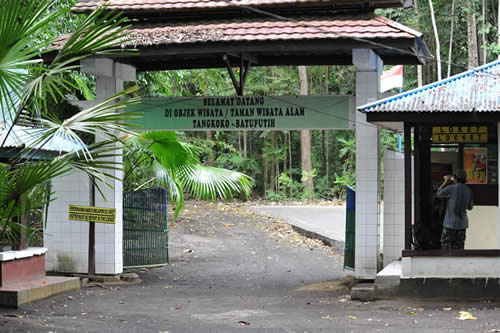
© 2014 Callyn Yorke
Ill-fated boat trip to the Kampung Kalinaung mangrove 18 June 2014

© 2014 Callyn Yorke
Tangkoko Ranger Home Stay Batu Putih, Sulawesi 17 June 2014
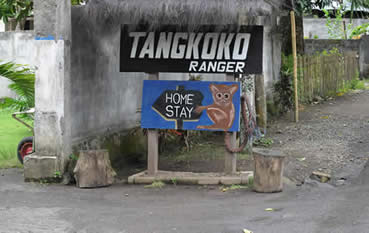
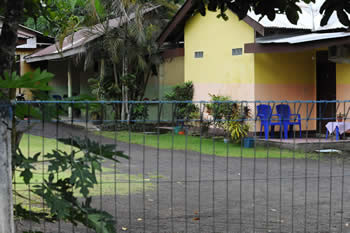
© 2014 Callyn Yorke
4) Gunung Ambang (GA: June 19-20, 2014: 1530-1920 hrs.; 0730-0920 hrs.). After nearly an all-day drive from Tangkoko N.P., we arrived in the mid-afternoon in the village of Sinsingon, at the foot of GA. There we were met by Julius, a park ranger who invited us to stay in his home for the evening. This was an unofficial "Home Stay" and apparently the only accomodations Christo could find for us in the area. We were treated with respect and warm hospitality, two large Indonesian meals (dinner that evening and breakfast the following morning), two sleeping rooms, and charged about $70 for all of it, including a strenuous though largely unproductive 4-hour birding tour on the north side of mountain, the evening of our arrival.
The following morning we drove through a pass to the south side of GA, where an unpaved road cut through a well-developed lower-montane rainforest. Kiki let us out of the car at several places and proceeded ahead so that Christo and I could walk a mile or so down the road, bird the surrounding forest, and be driven to the next spot. Many places along the road afforded eye-level views of birds in the forest canopy below us. Compared with Julius' mountaineering bird tour the prior evening, where we stumbled back to our car in the dark, the mountain road from GA to Kotamobagu was refreshing. And, much to our delight, the roadway through the forest produced some of the most exciting birding of our travels in Northern Sulawesi.
Birds of note found along the GA to Kotamobagu road included, Black Eagle, Brown Cuckoo-Dove, White-bellied Imperial Pigeon (endemic), Black-naped Fruit Dove, Caerulean Cuckoo-Shrike (endemic), Sulawesi Cicadabird (endemic), Sulawesi Drongo (endemic) White-breasted Wood Swallow, Fiery-browed Myna (endemic) and Scarlet Honeyeater.
Gunung Ambang road viewing south toward Kotamobagu, Sulawesi 20 June 2014
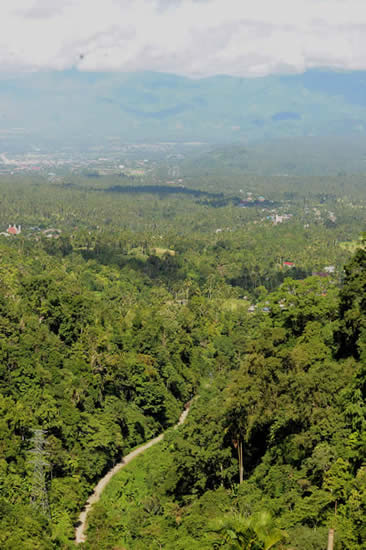
© 2014 Callyn Yorke
5a) Toraut, Dumoga Bone National Park (TOR: June 20, 2014: 1115-1730 hrs): Continuing our drive south from Gunung Ambang, we passed through Kotamabagu and arrived at the Toraut park headquarters at 1115 hrs., June 20. we were met by the park ranger-caretaker-guide, Jaimie, who showed us our rooms. Once an upscale World Wildlife Fund research facility for university staff and students, the place had fallen into serious disrepair over the past few years. My room ($30/night), though spacious, was infested by termites, mould and bedbugs. The shared lavatory was a tiny, tiled room with a squat-style toilet, a pale of water with a saucepan and a 3-ft. hose-bidet. There was a rusty shower head on the opposite wall aimed directly at the toilet. Hot water was unavailable. Intermittent rain continued through the afternoon and early evening, producing a welcome relief from the mid-day heat and humidity (65F to 85F; H 85-95%).
Nonetheless, there were birds to be found in and around the facility. Jaimie showed us the roosting place of a Speckled Boobok among the rafters in an abandoned building next to the kitchen. At dusk a Blue-faced Rail appeared in the garden outside the dining area. Both of these species were Sulawesi endemics and new for our trip-list. The forest and open areas surrounding the facility also produced Black Kite, Green Imperial Pigeon, Blue-backed Parrot and Asian Palm Swift.
Speckled Boobok (Ninox punctulata) Toraut, Sulawesi 20 June 2014
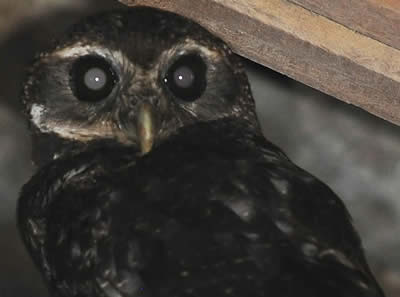
© 2014 Callyn Yorke
5b) Tombon, Dumoga-Bone NP (TOM: June 21 2014: 0545 - 1100 hrs.). We had an early start from Toraut and drove in the dark directly to the Tombon park headquarters, arriving there at dawn. We were met by Max, the resident park ranger, who took us to the nearby Maleo nesting area. Although the endemic and endangered Maleo ranges widely in Northern and Central Sulawesi, Tombon was one of the only places we would be likely to see this peculiar species.
Max unlocked a gate next to a Maleo recovery information sign, and led us on a path through a lowland rainforest dominated by palms and hardwoods. A hot springs in this area provides the subterranean warmth sought by Maleos when excavating burrows for their eggs (the odd helmet-like growth on the Maleo's head evidently functions as a thermometer). Although there were many older and some relatively recent excavation sites in a small clearing, we were unable to obtain more than a fleeting glimpse of an adult Maleo, despite more than three hours of searching and waiting patiently next to the nesting grounds. As a consolation prize, we observed Jaimie, one of the local researchers, excavate a fresh Maleo burrow and retrieve a single, large egg. The egg was quickly transported to a nearby pen and reburied inside for protection from predators (e.g. monitor lizards and local villagers). Next to the egg pen, a recently fledged Maleo chick awaited its release to the wild (photo). The Maleo recovery project, now in its 10th year, has hatched and released several hundred birds. The fate of the released birds is unknown. However, judging by the great number of Maleo nests in the area, the population appears to be relatively large and healthy.
Retrieving a freshly deposited Maleo egg, Tombon Maleo Recovery Project, Dumoga-Bone National Park, Sulawesi 21 June 2014
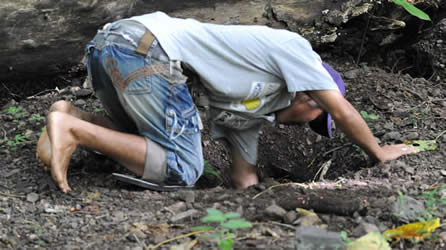
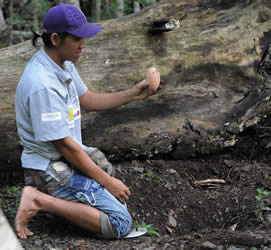
© 2014 Callyn Yorke
Reburial of a Maleo egg in a protected enclosure, Tombon, 21 June 2014

© 2014 Callyn Yorke
Releasing a fledgling Maleo (Macrocephalon maleo) into the wild, Tombon 21 June 2014
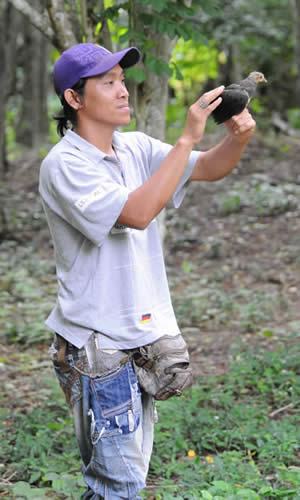
© 2014 Callyn Yorke
During our search for the Maleo we encountered a few other birds of interest, including three more endemics: Sulawesi Black Pigeon, Ashy Woodpecker (see frontispiece) and Pale-blue Monarch. Other species new for our trip-list, included Blue-breasted Quail and close-up views of an immature male Blue-breasted Pitta, the only representative of its family we encountered during my tour of northern Sulawesi.
Blue-breasted Pitta (Pitta erythrogaster) Tombon Sulawesi 21 June 2014
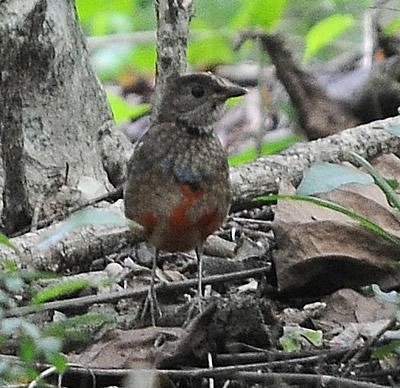
© 2014 Callyn Yorke